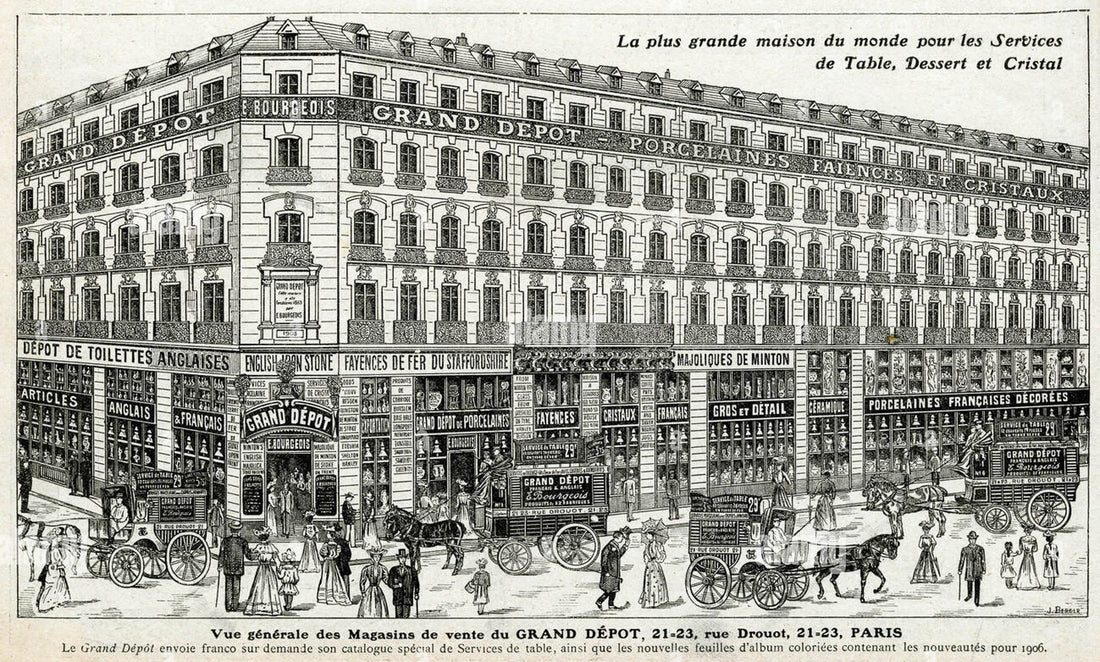
Emile Bourgeois and "Le Grand Dépôt" in Paris
Emile Bourgeois, a name synonymous with ingenuity and entrepreneurial spirit, transformed a modest china shop into “Le Grand Dépôt,” an iconic destination for exquisite ceramics, glassware, and porcelain. The story of Emile Bourgeois and his trailblazing venture captures the essence of a dynamic era when art, commerce, and craftsmanship converged to enrich everyday life.
The Humble Beginnings
Born in 1832 in Normandy, France, Emile Bourgeois’ journey began far from the grandeur of Paris. At the age of 16, he embarked on a career as a clerk in a Parisian china shop, where he developed a keen understanding of ceramics and the burgeoning market for fine tableware. His ambition and curiosity soon led him to London in 1856, where he became a salesman for prominent English pottery manufacturers, particularly those in Stoke-on-Trent, the epicentre of ceramic innovation. These formative years abroad exposed him to a world of design and production techniques that would later influence his own endeavours.
The Birth of Le Grand Dépôt

In 1862, Emile Bourgeois returned to Paris and established his own venture at 17 Rue Drouot. What started as a modest outlet for English ceramics quickly grew in scale and reputation. By 1863, Bourgeois expanded his operations to 21 Rue Drouot and christened the store “Le Grand Dépôt.” The name itself conveyed his vision: a grand repository of the finest tableware and home accessories, sourced from across Europe.
Unlike conventional shops, Le Grand Dépôt was a curated experience. Bourgeois’ discerning eye brought together an unparalleled selection of French porcelain, earthenware, and English ceramics, often produced to his own specifications. His partnership with renowned manufacturers such as Sarreguemines and Limoges allowed him to offer exclusive designs, blending traditional artistry with contemporary tastes.
A Parisian Institution
Le Grand Dépôt quickly became a household name, celebrated for its vast inventory and impeccable quality. The shop’s offerings extended beyond ceramics to include crystal glassware, making it a one-stop destination for discerning buyers. Advertisements of the era proudly proclaimed it as the largest house in the world for tableware and crystal services. Bourgeois’ clientele ranged from Parisian elites to middle-class families seeking to elevate their dining experiences with elegant yet practical pieces.
Collaborations with Sarreguemines
Among Bourgeois’ notable partnerships was his collaboration with the Sarreguemines faïence factory, renowned for its innovative techniques and artistic excellence. Together, they created exclusive patterns like the Louis XV design, epitomizing the opulent yet whimsical aesthetics of the time. Pieces bearing both the Sarreguemines and "Le Grand Dépôt" marks remain highly sought after by collectors, embodying a unique blend of craftsmanship and commercial ingenuity.
The Legacy of Emile Bourgeois
Emile Bourgeois’ contributions extended beyond commerce; he bridged the gap between artistry and everyday life. His ability to anticipate market trends and collaborate with esteemed manufacturers elevated "Le Grand Dépôt" to iconic status. While the shop no longer exists, its influence endures in the enduring appeal of the pieces it sold and the stories they carry.
The Allure of "Le Grand Dépôt" Pieces Today
Collectors and enthusiasts continue to cherish items from "Le Grand Dépôt" for their historical significance and aesthetic charm. From ornate toiletry sets to intricately designed dinner services, these treasures offer a tangible connection to a bygone era of elegance and innovation. Each piece tells a story of Emile Bourgeois’ vision—one that celebrated the beauty of everyday objects and their power to transform lives.


